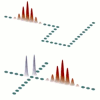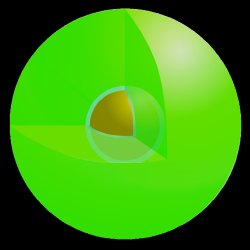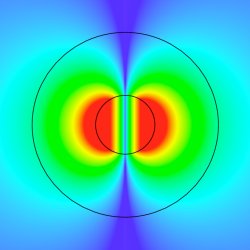-
Viewpoint on 'IONS'
Viewpoint on 'Scientific Literacy'
- Proudly sponsored by
-


-
LEGO-Optics

When I hear, I forget; when I see, I remember; but only when I do, do I understand. When it is not possible to let students play with expensive optical setups, LEGO comes into play.
-
Baffle the Bug!

Puzzled by the zebra’s appearance? Experimental data of recent research supports the idea that zebras developed their striped coat to stave off horseflies.
-
Optical Lattice Solitons: Guiding and Routing Light at Will

Optical solitons can propagate undistorted over indefinitely long distances. Solitons may interact with each other. Here we review some possibilities for soliton control.
The Smallest Laser Ever
A year before the 50th anniversary of the invention of the laser, laser physicists present a new breakthrough: the nanolaser. It is the smallest laser ever, which makes a whole new range of applications in nanophotonics possible.
How a spaser looks like. The spaser is formed by a gold core, which is surrounded by a glasslike shell filled with green dye molecule to create a sphere of 44 nanometers in diameter.
The spaser — such is the name of the new device — is the first of its kind to emit visible light on the nanoscale and, therefore, it represents a critical component for possible future technological applications based on optical circuits. An optical circuit works just like an electronic circuit but with photons rather than electrons, which is advantageous in terms of miniaturization, speed and bandwidth. The key components of any electronic circuit are divided into passive elements —such as resistors, inductors and capacitors — and active elements — such as transistors. Optical alternatives to passive elements [1] had been proposed before any alternative to active elements was demonstrated on the nanoscale [2-3]. What is still missing though is something capable of playing the role of an optical active element without requiring the huge macroscopic lasers of research labs as the source of photons.
The spaser is now able to play such a role by shrinking the size of lasers down to the nanoscale. Standard lasers come about by placing an amplifying material, called gain medium, between a pair of mirrors which form a cavity. Photons get amplified while they bounce back and forth across the gain medium. "Conventional lasers are limited in how small they can be made because their cavity cannot be smaller than half the wavelength of light," says Mikhail A. Noginov at Norfolk State University. This means, for example, that a green laser emitting at 530 nm cannot be made much smaller than 250 nm.
The spaser, on the other hand, "can reach sizes which are one order of magnitude below those of conventional lasers, since it provides a feedback mechanism not for photons but for oscillating surface plasmons. Otherwise, it works exactly as a standard laser," Noginov adds. "The main advantage of using any surface oscillations is a high concentration of energy in small volumes. […] For a spaser, the modal optical field is concentrated in three dimensions to a nanoscale region with the maximum size of around 10 nm or less," explains Mark I. Stockman at Georgia State University (Georgia, USA), who first proposed the spaser concept together with David Bergman at Tel Aviv University (Tel Aviv, Israel) in 2003 [4].

The spaser mode. A light at the proper wavelength can lead the dye molecules to fluoresce. The surface plasmons are generated and amplified by energy transfer from the excited molecules to the gold core of the spaser. The plasmons are then converted into photons of visible light, which is eventually emitted as a laser radiation. he inner and the outer circles represent the gold core (14 nanometers) and the glasslike shell (44 nanometers), respectively.
As with many breakthroughs in science, the spaser is the fruit of intense labor and cooperation among researchers. The work was possible, as Noginov himself points out, "only thanks to collaboration among three different groups." Stockman agrees: "It is definitely a great success and outstanding result for Noginov's group, which he was enthusiastically working on for several years, but this work became possible also due to the participation of an outstanding group from Cornell University lead by Ulrich Wiesner, that synthesized the spacers, and another excellent group lead by Vladimir M. Shalaev from Purdue University, that performed spectroscopy on the device." At the same time, the theoretical model for this nanolaser was developed by E. Narimanov at Purdue University.
"There may be several applications for spasers," predicts Stockman. "First of all, they are very bright and concentrated sources of optical energy on the nanoscale. This can be used in ultrasensing, ultramicroscopy, as a label in biomedicine, etc. However, probably, the most important application of the spaser is due to the fact that it is an ultrafast nanoscale amplifier of electric fields. It is just like a transistor in terms of the size, but when working at optical frequencies it is approximately a thousand times faster. It could be used instead of the transistor in ultrafast optoelectronic circuits and processor chips, for instance." Such an important discovery is the perfect pre-50th anniversary present for the world of lasers.
[1] N. Engheta, Circuits with Light at Nanoscales: Optical Nanocircuits Inspired by Metamaterials, Science 317, 1698-1702 (2007).
[2] J. Hwang et al., A Single-molecule Optical Transistor, Nature 460, 76-80 (2009).
[3] G. Volpe, What a Molecular Transistor!, Opt. Photon. Focus 7, 2 (2009), http://www.opfocus.org/index.php?topic=story&v=7&s=2.
[4] D. J. Bergman & M. I. Stockman, Surface Plasmon Amplification by Stimulated Emission of Radiation: Quantum Generation of Coherent Surface Plasmons in Nanosystems, Phys. Rev. Lett. 90, 027402 (2003).
Giorgio Volpe
2009 © Optics & Photonics Focus
GV is currently working on his doctoral thesis at ICFO - The Institute of Photonic Sciences, Barcelona (Spain).

M. A. Noginov, G. Zhu, A. M. Belgrave, R. Bakker, V. M. Shalaev, E. E. Narimanov, S. Stout, E. Herz, T. Suteewong & U. Wiesner, Demonstration of a spaser-based nanolaser, Nature (2009) 460, 1110-1112 (link).